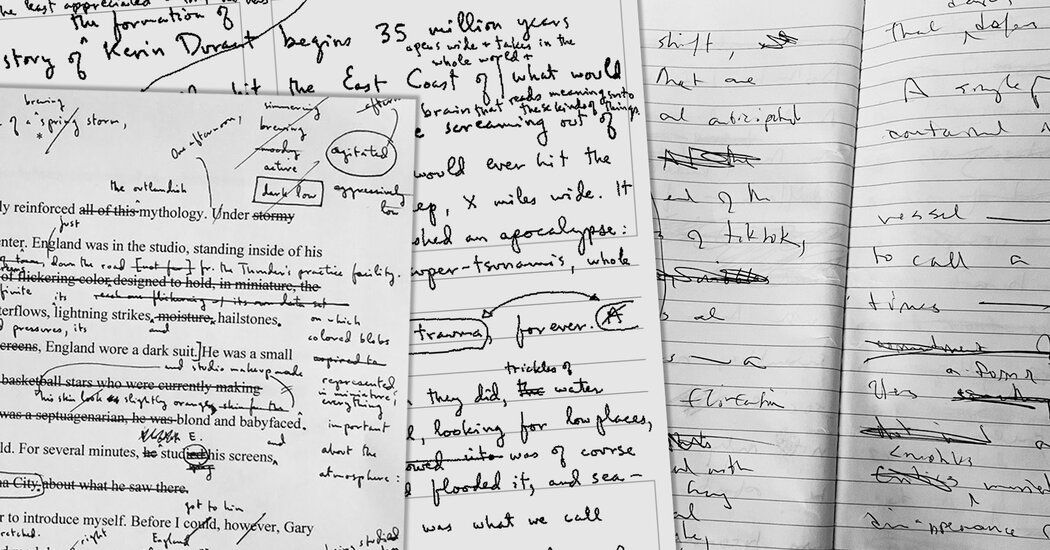Write your weird
Advice from Neil Gaiman, writing in multiple viewpoints, writing in longhand, and the importance of showing up.

Strap yourself in for another edition of the Draft Mode newsletter, flung your way with much devotion by yours truly, daft writer boy, Iain Broome.
The image above is a photo of my dad's shed. He spends a lot of time in there. Woodturning. Tinkering. Living his very best life. He's extremely productive, despite the apparent chaos.
It's almost as if you don't really need a fancy desk or view of the sea to get stuff done. Surround yourself with the work. Seems a good place to start.
By the way, I asked him if perhaps he ought to buy a new chair. He scoffed and assured me there was, "Nothing wrong with this one."
Enjoy the exciting content below. Speak soon.
Iain
Links of the week
Every issue I collect and share the best advice, apps and other shenanigans that I find on my internet travels. Find something useful? Subscribe for free.
Writing advice from Neil Gaiman - on honesty, rejection and reading as a craftsperson
Enjoy this five-minute clip from Neil Gaiman's Masterclass course. I think the last minute is particularly brilliant and... true. The idea that you need to be prepared to reveal a little of yourself in your writing. Not in a personal sense, but through your voice. My best writing comes when I'm able to do that.
This is such a great question to ask yourself from time to time. The link here is to a beautifully written and very personal answer from Yanyi, author and sender of an excellent newsletter.
I started writing stories and poems and song lyrics when I was a teenager. It was not a normal thing to do for a young lad growing up in an old mining area in the near-north of England. But I loved writing and I especially enjoyed people reading what I had written. And then, fingers crossed, saying nice things about it.
It’s much harder for me to say why I write now. Or why I continue writing, given it’s so difficult to squeeze it into my everyday life as a father of four with a full-time job. But I do, and perhaps it’s what Neil Gaiman talks about in the video above.
The need to have a space of one’s own. A way to share a little of who I am and where I come from. Some truth. A voice.
How to write a novel in multiple points of view
Some great tips on writing from several points of view in this post from Roz Morris. I’m toying with the idea for my work in progress, but I know it can be tricky to do well. If you’re looking for multi-view inspiration, I can recommend Max Porter’s two brilliant novels, Grief is the Thing With Feathers and Lanny.
The only 4 sections every About Me page needs
This piece from the excellent resource bank over at Ghost isn’t aimed specifically at creative writers, but it does include some good things for you to think about. I need to take note, as I haven’t updated my own about page in years, which is kind of embarrassing.

Quite enjoyed this piece on two New York Times journalists who do most of their writing by hand before moving to digital. I know a couple of novelists who do the same thing. It’s never worked for me, but I can see the benefits of getting away from the screen entirely. Anything to avoid distractions.
Why ‘showing up’ might be the most important trick as a writer
These 10 short tips from David Gane for making sure you move forward with your writing include some excellent reminders if you’re feeling stuck.
Write your weird
Have you ever decided not to pursue a book or story idea because you thought it was too weird? A project you abandoned early because you thought it wouldn’t sell or that no one would be interested?
I’ve discarded a lot of weird in the last few years. Well, not weird perhaps, but certainly different and almost definitely less commercial than any agent or publisher might prefer. I’ve started writing these oddities, sometimes liked them, but ended up putting them to one side.
The only example that saw any light of day was Leisure Club, a fictional podcast. I sent a demo to subscribers of this very newsletter and shared their feedback with everyone. Granted, it was a little strange. It may have gone nowhere. But I wish I’d had the gumption to write and record a full season, put it into the world and be able to point at it now and say, “Hey, look at this weird thing I made.”
Because weird can be brilliant. Weird can lead to some of your best work, which may or may not even end up weird, but that’s not the point. The point is to work on what you believe in and whatever gives you that fuzzy feeling that comes when writing is fun. When the ideas flow, weird or otherwise.
So, explore. Experiment. Write stupid sentences. Be dark, daft or difficult. Invent a wild new format. Mix it, mash it, make it whatever you want it to be. And if in doing so you have a fantastic time and think, "Hey, I might be on to something here," then please go on and finish that thing.
Write your weird and you won't regret it. You might not produce a bestseller. It might not go anywhere at all. But it will be an idea ventured. And you will gain from the experience. Your voice will be a little louder, a little clearer.
I’m currently writing weird. It's a small project that has something to say and I’m determined to finish it. Then I’m going to put it into the world. And forevermore, I shall point at the weird thing that I made. With fondness and pride.
In other links
- 4 Simple Productivity Hacks for Creative Writers
- Weekly newsletter packed with virtual author and writer events
- 7 Things You'll Need to Write a Strong Story Structure
- Practical Ways to Post Something Every Day
- Don’t Overthink It: The Argument For Just Starting to Write
Tweets of the week
So many bad tweets. These are good ones. Follow @iainbroome on Twitter or @DraftModeHQ for newsletter notifications.
The only rule of fiction writing:
— Lincoln Michel (@TheLincoln) March 9, 2022
You can do anything but you can't do everything and you have to do something.
stop shaming people for reading kids’ books. adult books are about sad people having affairs while kids’ books have a magic tree house or a worm driving an apple. you tell me who’s winning
— Owl! at the Library 😴🧙♀️ (@SketchesbyBoze) March 10, 2022
I'm a big fan of the pomodoro method, which, if you aren't familiar with it, is when you do 25 minutes of focused work and then take a 95-minute break
— Drew McKevitt (@drewmckevitt) February 22, 2022
First-time reader?
Draft Mode is a weekly newsletter by Iain Broome, author of the novel, A is for Angelica. Join 1400+ subscribers and start receiving the tools and tips that help you improve your craft and promote your writing. Subscribe for free.
Join 1700+ subscribers
I send Draft Mode, a monthly newsletter about writing, creativity, publishing and making things on the internet. Pop your email address in the box to join us.




